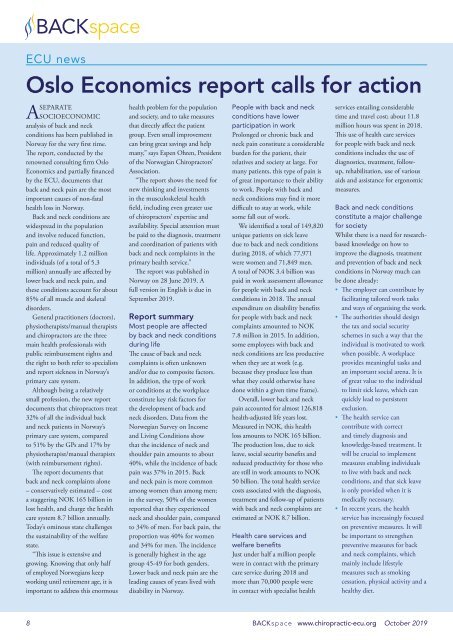Backspace Oct19
Backspace Oct19
Backspace Oct19
You also want an ePaper? Increase the reach of your titles
YUMPU automatically turns print PDFs into web optimized ePapers that Google loves.
ECU news<br />
Oslo Economics report calls for action<br />
A SEPARATE<br />
SOCIOECONOMIC<br />
analysis of back and neck<br />
conditions has been published in<br />
Norway for the very first time.<br />
The report, conducted by the<br />
renowned consulting firm Oslo<br />
Economics and partially financed<br />
by the ECU, documents that<br />
back and neck pain are the most<br />
important causes of non-fatal<br />
health loss in Norway.<br />
Back and neck conditions are<br />
widespread in the population<br />
and involve reduced function,<br />
pain and reduced quality of<br />
life. Approximately 1.2 million<br />
individuals (of a total of 5.3<br />
million) annually are affected by<br />
lower back and neck pain, and<br />
these conditions account for about<br />
85% of all muscle and skeletal<br />
disorders.<br />
General practitioners (doctors),<br />
physiotherapists/manual therapists<br />
and chiropractors are the three<br />
main health professionals with<br />
public reimbursement rights and<br />
the right to both refer to specialists<br />
and report sickness in Norway’s<br />
primary care system.<br />
Although being a relatively<br />
small profession, the new report<br />
documents that chiropractors treat<br />
32% of all the individual back<br />
and neck patients in Norway’s<br />
primary care system, compared<br />
to 51% by the GPs and 17% by<br />
physiotherapist/manual therapists<br />
(with reimbursement rights).<br />
The report documents that<br />
back and neck complaints alone<br />
– conservatively estimated – cost<br />
a staggering NOK 165 billion in<br />
lost health, and charge the health<br />
care system 8.7 billion annually.<br />
Today’s ominous state challenges<br />
the sustainability of the welfare<br />
state.<br />
“This issue is extensive and<br />
growing. Knowing that only half<br />
of employed Norwegians keep<br />
working until retirement age, it is<br />
important to address this enormous<br />
health problem for the population<br />
and society, and to take measures<br />
that directly affect the patient<br />
group. Even small improvement<br />
can bring great savings and help<br />
many,” says Espen Ohren, President<br />
of the Norwegian Chiropractors’<br />
Association.<br />
“The report shows the need for<br />
new thinking and investments<br />
in the musculoskeletal health<br />
field, including even greater use<br />
of chiropractors’ expertise and<br />
availability. Special attention must<br />
be paid to the diagnosis, treatment<br />
and coordination of patients with<br />
back and neck complaints in the<br />
primary health service.”<br />
The report was published in<br />
Norway on 28 June 2019. A<br />
full version in English is due in<br />
September 2019.<br />
Report summary<br />
Most people are affected<br />
by back and neck conditions<br />
during life<br />
The cause of back and neck<br />
complaints is often unknown<br />
and/or due to composite factors.<br />
In addition, the type of work<br />
or conditions at the workplace<br />
constitute key risk factors for<br />
the development of back and<br />
neck disorders. Data from the<br />
Norwegian Survey on Income<br />
and Living Conditions show<br />
that the incidence of neck and<br />
shoulder pain amounts to about<br />
40%, while the incidence of back<br />
pain was 37% in 2015. Back<br />
and neck pain is more common<br />
among women than among men;<br />
in the survey, 50% of the women<br />
reported that they experienced<br />
neck and shoulder pain, compared<br />
to 34% of men. For back pain, the<br />
proportion was 40% for women<br />
and 34% for men. The incidence<br />
is generally highest in the age<br />
group 45-49 for both genders.<br />
Lower back and neck pain are the<br />
leading causes of years lived with<br />
disability in Norway.<br />
People with back and neck<br />
conditions have lower<br />
participation in work<br />
Prolonged or chronic back and<br />
neck pain constitute a considerable<br />
burden for the patient, their<br />
relatives and society at large. For<br />
many patients, this type of pain is<br />
of great importance to their ability<br />
to work. People with back and<br />
neck conditions may find it more<br />
difficult to stay at work, while<br />
some fall out of work.<br />
We identified a total of 149,820<br />
unique patients on sick leave<br />
due to back and neck conditions<br />
during 2018, of which 77,971<br />
were women and 71,849 men.<br />
A total of NOK 3.4 billion was<br />
paid in work assessment allowance<br />
for people with back and neck<br />
conditions in 2018. The annual<br />
expenditure on disability benefits<br />
for people with back and neck<br />
complaints amounted to NOK<br />
7.8 million in 2015. In addition,<br />
some employees with back and<br />
neck conditions are less productive<br />
when they are at work (e.g.<br />
because they produce less than<br />
what they could otherwise have<br />
done within a given time frame).<br />
Overall, lower back and neck<br />
pain accounted for almost 126,818<br />
health-adjusted life years lost.<br />
Measured in NOK, this health<br />
loss amounts to NOK 165 billion.<br />
The production loss, due to sick<br />
leave, social security benefits and<br />
reduced productivity for those who<br />
are still in work amounts to NOK<br />
50 billion. The total health service<br />
costs associated with the diagnosis,<br />
treatment and follow-up of patients<br />
with back and neck complaints are<br />
estimated at NOK 8.7 billion.<br />
Health care services and<br />
welfare benefits<br />
Just under half a million people<br />
were in contact with the primary<br />
care service during 2018 and<br />
more than 70,000 people were<br />
in contact with specialist health<br />
services entailing considerable<br />
time and travel cost; about 11.8<br />
million hours was spent in 2018.<br />
This use of health care services<br />
for people with back and neck<br />
conditions includes the use of<br />
diagnostics, treatment, followup,<br />
rehabilitation, use of various<br />
aids and assistance for ergonomic<br />
measures.<br />
Back and neck conditions<br />
constitute a major challenge<br />
for society<br />
Whilst there is a need for researchbased<br />
knowledge on how to<br />
improve the diagnosis, treatment<br />
and prevention of back and neck<br />
conditions in Norway much can<br />
be done already:<br />
• The employer can contribute by<br />
facilitating tailored work tasks<br />
and ways of organising the work.<br />
• The authorities should design<br />
the tax and social security<br />
schemes in such a way that the<br />
individual is motivated to work<br />
when possible. A workplace<br />
provides meaningful tasks and<br />
an important social arena. It is<br />
of great value to the individual<br />
to limit sick leave, which can<br />
quickly lead to persistent<br />
exclusion.<br />
• The health service can<br />
contribute with correct<br />
and timely diagnosis and<br />
knowledge-based treatment. It<br />
will be crucial to implement<br />
measures enabling individuals<br />
to live with back and neck<br />
conditions, and that sick leave<br />
is only provided when it is<br />
medically necessary.<br />
• In recent years, the health<br />
service has increasingly focused<br />
on preventive measures. It will<br />
be important to strengthen<br />
preventive measures for back<br />
and neck complaints, which<br />
mainly include lifestyle<br />
measures such as smoking<br />
cessation, physical activity and a<br />
healthy diet.<br />
8BACKspace www.chiropractic-ecu.org October 2019<br />
01-32 <strong>Backspace</strong> <strong>Oct19</strong>.indd 8 10/09/2019 16:14





